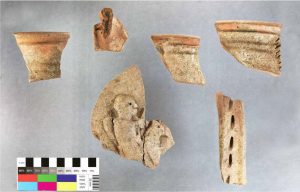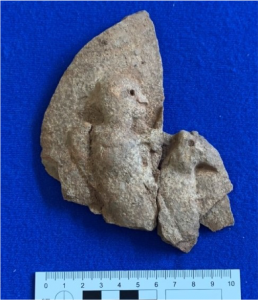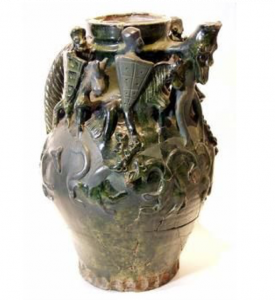Find Of The Month – September 2021
- 21st January 2022
Temple Laugherne Knight Jug
Perhaps one of the most unusual finds from the past two years was this medieval jug which was found during excavations at Temple Laugherne.
Anyone at Worcestershire Archaeology Day 2021 will have seen great talks on a variety of subjects. This jug featured in the Fascinating Finds talk. Sometimes we have delay sharing about finds due to confidentiality whilst excavations are taking place. This is one of a number of finds we’ve been waiting to share with you.
Temple Laugherne knight jug
An amazing medieval jug featuring decoration of a knight on horseback was found just outside Worcester. It consisted of 23 sherds, a number of which fitted together nicely. It was made in Worcester in the 13th-14th century and had a thin and patchy green glaze (now largely decayed) over a white slip, indicating it most likely to have had a fairly elaborate bridge-spout when complete.
However, the decoration that really makes it really stand out, is the moulding on the front which depicts a knight on horseback. Although abrasion and crude modelling means it’s not that easy to pick out detail, the knight is mounted on the horse, which has its front legs extended as if galloping. Although surface abrasion has resulted in the loss of some detail, the faint outline of what appears to be a conical nasal helmet can be seen on the knight. There also appears to be some modelling in the cheek area, which may represent cheek guards or chainmail.
The only facial feature present is the eye which looks to have been formed by stabbing with a small, circular point. There is the outline of a shield tucked in behind the trunk of the figure, as if being carried on the back. The hands are modelled without any detail but appear to be holding the horse’s reigns as well as another object, thought to be a weapon, which is straight and pointing upwards. Due to the sherd having broken at this point, it is only possible to speculate as to what this weapon was, but on balance, for this period it seems most likely a sword. The horse is even more basic in appearance, having a very basic form with a snout, two ears and a single, slightly bigger eye formed in the same manner as that of the knight. The front legs appear to have been formed slightly curved piece of clay, with an incised line running the length to give the appearance of two.
This is the first vessel of its kind identified in Worcestershire. Traditionally Knight jugs appear to be the product of a limited number of industries largely confined to the North and East Midlands and Yorkshire (McCarthy and Brooks 1988, 228, 247, 266 and 277). However, the Worcester potters are known to have produced zoomorphic/anthropomorphic vessels and roof finials during the 13th-14th century, with examples identified within assemblages from Worcester and nearby Droitwich. These included a horse and rider finial from Droitwich, thought to represent the ruling King of the time it was made. It is interesting to note that such vessels and finials do not appear to have been produced in Malvernian fabrics, the other main producer of pottery in Worcestershire. In fact, where still in-situ, it has been noted that roof finials of Worcester production were sometimes mounted in ridge tiles of Malvernian production. Therefore, it would seem that the production of zoomorphic/anthropomorphic objects was a particular specialism developed by the Worcester potters during the 13th-14th centuries.
Knight jugs from elsewhere are generally more elaborate and highly decorated than the example from Temple Laugherne, and those produced in Scarborough and Nottingham are generally of tubular spouted from. However, although not as highly decorated or complex, the suspected use of a bridge-spouted form, one of the more unusual and ornamental forms produced by Worcester industry, would seem to be a deliberate choice. It is also notable that other examples of knight jugs are almost exclusively associated with urban sites, making the find of this vessel on a small, lower order settlement in rural Worcestershire even more curious. Furthermore, the rest of the pottery assemblage was very basic, consisting mainly of locally produced Worcester and Malvernian cooking pots. There is of course the connection with the Knight’s Templar, who owned the land between 1249 and 1311, but quite how this elaborate jug came to be found here it was is a mystery.



Post a Comment